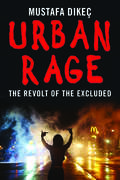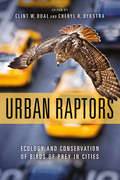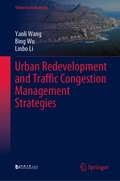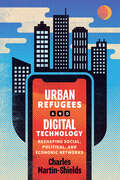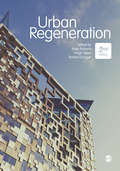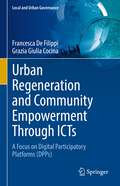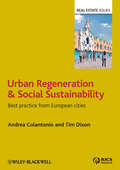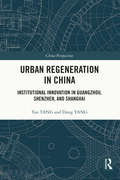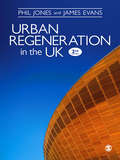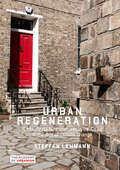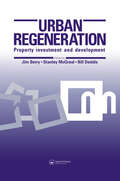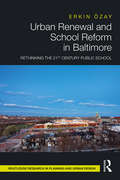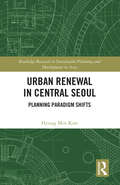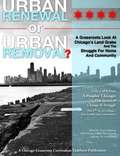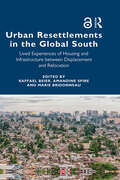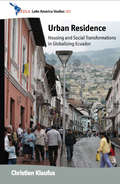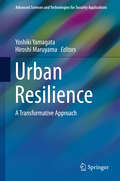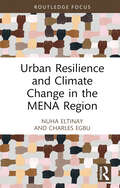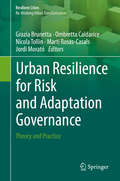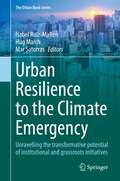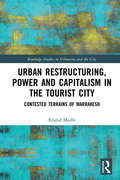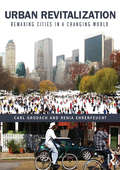- Table View
- List View
Urban Rage: The Revolt of the Excluded
by Mustafa DikecA timely and incisive examination of contemporary urban unrest that explains why riots will continue until citizens are equally treated and politically included In the past few decades, urban riots have erupted in democracies across the world. While high profile politicians often react by condemning protestors’ actions and passing crackdown measures, urban studies professor Mustafa Dikeç shows how these revolts are in fact rooted in exclusions and genuine grievances which our democracies are failing to address. In this eye-opening study, he argues that global revolts may be sparked by a particular police or government action but nonetheless are expressions of much longer and deep seated rage accumulated through hardship and injustices that have become routine. Increasingly recognized as an expert on urban unrest, Dikeç examines urban revolts in the United States, United Kingdom, France, Sweden, Greece, and Turkey and, in a sweeping and engaging account, makes it clear that change is only possible if we address the failures of democratic systems and rethink the established practices of policing and political decision-making.
Urban Raptors: Ecology and Conservation of Birds of Prey in Cities
by Clint W. Boal Cheryl R. DykstraRaptors are an unusual success story of wildness thriving in the heart of our cities—they have developed substantial populations around the world in recent decades. But there are deeper issues around how these birds make their urban homes. New research provides insight into the role of raptors as vital members of the urban ecosystem and future opportunities for protection, management, and environmental education.A cutting-edge synthesis of over two decades of scientific research, Urban Raptors is the first book to offer a complete overview of urban ecosystems in the context of bird-of-prey ecology and conservation. This comprehensive volume examines urban environments, explains why some species adapt to urban areas but others do not, and introduces modern research tools to help in the study of urban raptors. It also delves into climate change adaptation, human-wildlife conflict, and the unique risks birds of prey face in urban areas before concluding with real-world wildlife management case studies and suggestions for future research and conservation efforts.Boal and Dykstra have compiled the go-to single source of information on urban birds of prey. Among researchers, urban green space planners, wildlife management agencies, birders, and informed citizens alike, Urban Raptors will foster a greater understanding of birds of prey and an increased willingness to accommodate them as important members, not intruders, of our cities.
Urban Redevelopment and Traffic Congestion Management Strategies (Urban Sustainability)
by Bing Wu Yanli Wang Linbo LiThis book focuses on the relationship between urban land redevelopment and traffic systems and discusses the related research. Consisting of three main parts, the first analyzes the interaction between land redevelopment and traffic congestion as well as the mechanisms and causes of traffic congestion. The second part presents strategies for the prevention and control of traffic congestion under urban land redevelopment, proposing a two-stage evaluation system of traffic congestion pre-inspection and traffic impact analysis in the planning and implementation stages of land redevelopment. Lastly, the third section includes an application case analysis of the proposed traffic congestion management strategy.
Urban Refugees and Digital Technology: Reshaping Social, Political, and Economic Networks (McGill-Queen's Refugee and Forced Migration Studies)
by Charles Martin-ShieldsRefugees and displaced people are increasingly moving to cities around the world, seeking out the social, economic, and political opportunity that urban areas provide. Against this backdrop digital technologies are fundamentally changing how refugees and displaced people engage with urban landscapes and economies where they settle.Urban Refugees and Digital Technology draws on contemporary data gathered from refugee communities in Bogotá, Nairobi, and Kuala Lumpur to build a new theoretical understanding of how technological change influences the ways urban refugees contribute to the social, economic, and political networks in their cities of arrival. This data is presented against the broader history of technological change in urban areas since the start of industrialization, showing how displaced people across time have used technologized urban spaces to shape the societies where they settle. The case studies and history demonstrate how refugees’ interactions with environments that are often hostile to their presence spur novel adaptations to idiosyncratic features of a city’s technological landscape.A wide-ranging study across histories and geographies of urban displacement, Urban Refugees and Digital Technology introduces readers to the myriad ways technological change creates spaces for urban refugees to build rich political, social, and economic lives in cities.
Urban Regeneration
by Peter Roberts Rachel Granger Hugh SykesUrban Regeneration is widely discussed but less widely understood. Fully revised with important new policy, case studies and international analysis, the Second Edition of Urban Regeneration will correct that. The 16 chapters, written by leading experts, are organised into four sections: The Context for Urban Regeneration: The history and evolution Major Themes and Topics: Including Housing, Community, Employment and the Environment Key Issues in Managing Urban Regeneration: Including Legal and Organisational considerations Experience Elsewhere and a View of the Future: Expanded section now discussing Australia and the Celtic Fringe as well as Europe and the USA This is the essential handbook for practitioners involved in regeneration, as well as students of planning, urban studies, geography and architecture.
Urban Regeneration
by Sir Hugh Sykes Professor Peter Roberts Rachel GrangerUrban Regeneration is widely discussed but less widely understood. Fully revised with important new policy, case studies and international analysis, the Second Edition of Urban Regeneration will correct that. The 16 chapters, written by leading experts, are organised into four sections: The Context for Urban Regeneration: The history and evolution Major Themes and Topics: Including Housing, Community, Employment and the Environment Key Issues in Managing Urban Regeneration: Including Legal and Organisational considerations Experience Elsewhere and a View of the Future: Expanded section now discussing Australia and the Celtic Fringe as well as Europe and the USA This is the essential handbook for practitioners involved in regeneration, as well as students of planning, urban studies, geography and architecture.
Urban Regeneration and Community Empowerment Through ICTs: A Focus on Digital Participatory Platforms (DPPs) (Local and Urban Governance)
by Francesca De Filippi Grazia Giulia CocinaThis book deals with the issue of Digital Participatory Platforms (DPPs) for urban governance. It explains the role and potential that ICTs play in the decision-making processes of the Public Administration and citizens' participation. The book also illustrates the main technologies that encourage innovation and social inclusion, with particular focus on use of DPPs in urban regeneration programs and projects. It presents international best practices from local to European level and it describes the process of creation, development and testing of a DPP project with reference to the Italian case. The book is divided into three parts:the first one gives a framework of neighborhood urban and civic engagement through ICTs, studying in depth the role of ICTs in support of Public Administration’s processes and citizens participation;the second part investigates the topic of Digital Participatory Platforms (DPPs) with the description of their potentialities, the presentation of some international best practices and a specific focus on the Italian context;the third part draws the conclusions of this path by asking which are the main challenges in the adoption of Digital Participatory Platforms, in order to increase citizen participation and collaboration via technology.
Urban Regeneration and Social Sustainability: Best Practice from European Cities (Real Estate Issues #53)
by Andrea Colantonio Tim DixonUrban regeneration is a key focus for public policy throughout Europe. This book examines social sustainability and analyses its meaning. The authors offer a comprehensive European perspective to identify best practices in sustainable urban regeneration in five major cities in Spain, Italy, Netherlands, Germany, and the UK. This authoritative overview of the scholarly literature makes the book essential reading for researchers and post-graduate students in sustainable development, real estate, geography, urban studies, and urban planning, as well as consultants and policy advisors in urban regeneration and the built environment.
Urban Regeneration in China: Institutional Innovation in Guangzhou, Shenzhen, and Shanghai (China Perspectives)
by Yan Tang Dong YangThe book examines institutional innovation in urban regeneration in Guangzhou, Shenzhen, and Shanghai, three Chinese cities that have experienced sweeping changes in recent years, providing an ideal guide to the development of urban regeneration practices in China. As a starting point, the book revisits relevant theoretical developments and the institutional experiences of urban regeneration in some Asian pioneer cities and regions, such as Hong Kong, Taipei, Tokyo, and Singapore. Moving on to the Chinese mainland cities themselves, the core comparative study investigates the institutional systems, key policies, planning formulations, and implementation paths in the urban regeneration process of the three cities. Gains and losses that have resulted from each city's institutional construction and reformation are discussed, as well as the underlying reasons for these. Drawing on these case studies and comparisons, the book puts forward some generic rules for urban regeneration institutional innovation, offering a valuable frame of reference for other cities and regions. The book will appeal to scholars interested in urban regeneration and renewal, as well as urban planners, architects, policymakers, and urban development administrators.
Urban Regeneration in the UK: Boom, Bust and Recovery
by Dr Phil Jones Dr James Evans"A thorough update of what was already an excellently written, accessible and well-used book. Coverage of the key issues to impact on regeneration in the UK since the 2008 financial crisis is comprehensive, and ensures that this latest edition will remain a key reference work for students and practitioners alike." - Dr David Jarvis, Coventry University and Deputy Director, Applied Research Centre in Sustainable Regeneration (SURGE) "An accessible text for students that provides an excellent summary of the challenges facing the UK regeneration sector up to and including the present age of austerity." - Dr Lee Pugalis School of Built Environment, Northumbria University An engaging, systematic guide to the most dramatic transformation of our urban landscape since post-war reconstruction. This new edition has been fully revised to include: Improved pedagogical features, including an expanded glossary and increased visuals, as well as key learning points, useful websites and suggestions for further reading More content on local sustainability and issues linked to climate change A new chapter, 'Scaling Up', which examines how regeneration operates when considering very large schemes, such as the London 2012 Olympics. Jones and Evans draw together a mass of information around key themes in governance, sustainability, competition and design - from policy reports to academic studies - into a single coherent text, making this essential reading for anyone studying or working in the field of urban regeneration and planning.
Urban Regeneration: A Manifesto for transforming UK Cities in the Age of Climate Change
by Steffen LehmannUrban Regeneration — A Manifesto for transforming UK Cities in the Age of Climate Change explores and offers guidance on the complex process of how to transform cities, continuing the unfinished project of the seminal 1999 text Towards an Urban Renaissance. It is a 21st-century manifesto of urban principles compiled by a prominent urbanist, for the regeneration of UK cities, focusing on the characteristics of a ‘good place’ and the strategies of sustainable urbanism. It asks readers to consider how we can best transform the derelict, abandoned and run-down parts of cities back into places where people want to live, work and play.The book frames an architecture of re-use that translates and combines the complex ‘science of cities’ and the art of urban and architectural design into actionable and practical guidance on how to regenerate cities. Fascinated by the typology and value of the compact UK and European city model, Lehmann introduces the concept of ‘high density without high buildings’ as a solution that will make our cities compact, walkable, mixed-use and vibrant again.
Urban Regeneration: Property Investment and Development
by Stanley McGreal Jim Berry Bill DeddisThis book provides an in-depth analysis of the role of property investment and development in the urban regeneration process. It relates the physical, economic, financial and environmental aspects of urban change and development to the realities of particular cities by case studies drawn from Britain and Europe.
Urban Renewal and School Reform in Baltimore: Rethinking the 21st Century Public School
by Erkin ÖzayUrban Renewal and School Reform in Baltimore examines the role of the contemporary public school as an instrument of urban design. The central case study in this book, Henderson-Hopkins, is a PK-8 campus serving as the civic centerpiece of the East Baltimore Development Initiative. This study reflects on the persistent notions of urban renewal and their effectiveness for addressing the needs of disadvantaged neighborhoods and vulnerable communities. Situating the master plan and school project in the history and contemporary landscape of urban development and education debates, this book provides a detailed account of how Henderson-Hopkins sought to address several reformist objectives, such as improvement of the urban context, pedagogic outcomes, and holistic well-being of students. Bridging facets of urban design, development, and education policy, this book contributes to an expanded agenda for understanding the spatial implications of school-led redevelopment and school reform.
Urban Renewal in Central Seoul: Planning Paradigm Shifts (Routledge Research in Sustainable Planning and Development in Asia)
by Hyung Min KimKim details a brief history of urban renewal in central Seoul through articulating urban planning paradigm shifts. This book illustrates four main themes in central Seoul: the restoration of the Cheonggye stream, the redevelopment of the Sewoon Plaza, the enhancement of walkability and public transport networks, and history- centred urban renewal.Urban renewal is seen as a remedy for urban sprawl and is appreciated for its capacity to make use of pre-existing infrastructure and cultural assets in high- density urban areas. However, it faces critical challenges, such as fragmented property ownership and escalated land prices in comparison with peri- urban areas. The book focuses on how planning policies have shaped the urban renewal process in central Seoul, South Korea. Spatial development policies for central Seoul have been changed from modern transport facilities, post- war reconstruction, informality, industrialisation to walkability, sustainability, and social cohesion in line with economic restructuring. In recent times, there has been a significant change in thinking towards creating public spaces for walking, preserving historical sites and heritage, and maintaining green spaces. These interconnected topics contribute to understanding the complexity of urban renewal.This book is a useful read for researchers on urban planning and policies who are keen to understand the complicated process of urban renewal and ways to revitalise economic and human activities and transform built environments.
Urban Renewal or Urban Removal?: A Grassroots Look At Chicago's Land Grabs And The Struggle For Home And Community
by Chicago Grassroots Curriculum TaskforceA Grassroots Look at Chicago's Land Grabs and the Struggle for Home and Community WHAT YOU'LL FIND IN URUR?: (Gr. 8 to Grad Level) *In-depth chronological coverage of the Chicago area from the 1700s to 2012 *Six main parts, including the Community Appendix *10+ primary sources such as official letters, organizing pamphlets, leaflets, brochures, and more *Historical analysis of Chicago's land, housing, and development patterns including public housing *Multicultural-based histories of working and lower-income communities and people of color *Contributions from local community (s)heroes in various struggles for dignity and justice. *Original and historic photographs, artwork, maps, charts, and other visuals *Excerpts from interviews, articles, studies, summaries, speeches, papers, poetry, lyrics and others
Urban Resettlements in the Global South: Lived Experiences of Housing and Infrastructure between Displacement and Relocation
by Raffael BeierUrban Resettlements in the Global South provides new perspectives on resettlement through an urban studies lens. To date, resettlement has been theorised through development studies and refugee studies, but urban resettlement is also a major dimension of urban development in the Global South and may help to rethink contemporary urban dynamics between spectacular new town developments and rising incidences of eviction and displacement. Conceptualising resettlement as a binding notion between production/regeneration and destruction/demolition of urban space helps to illuminate interdependencies and to underline significant ambiguities within affected people’s perspectives towards resettlement projects. This volume will offer an interesting selection of ten different case studies with rich empirical data from Latin America, North and Sub-Saharan Africa, and Asia, focused on each stage of resettlement (before, during, after relocation) through different timescales. By offering a frame for analysing and rethinking resettlement within urban studies, it will support any scholar or expert dealing with resettlement, displacement, and housing in an urban context, seeking to improve housing and planning policies in and for the city.
Urban Residence
by Christien KlaufusRiobamba and Cuenca, two intermediate cities in Ecuador, have become part of global networks through transnational migration, incoming remittances, tourism, and global economic connections. Their landscape is changing in several significant ways, a reflection of the social and urban transformations occurring in contemporary Ecuadorian society. Exploring the discourses and actions of two contrasting population groups, rarely studied in tandem, within these cities--popular-settlement residents and professionals in the planning and construction sector--this study analyzes how each is involved in house designs and neighborhood consolidation. Ideas, ambitions, and power relations come into play at every stage of the production and use of urban space, and as a result individual decisions about both house designs and the urban layout influence the development of the urban fabric. Knowledge about intermediate cities is crucial in order to understand current trends in the predominantly urban societies of Latin America, and this study is an example of needed interdisciplinary scholarship that contributes to the fields of urban studies, urban anthropology, sociology, and architecture.
Urban Resilience
by Yoshiki Yamagata Hiroshi MaruyamaThis book is on urban resilience - how to design and operate cities that can withstand major threats such as natural disasters and economic downturns and how to recover from them. It is a collection of latest research results from two separate but collaborating research groups, namely, researchers in urban design and those on general resilience theory. The book systematically deals with the core aspects of urban resilience: systems, management issues and populations. The taxonomy can be broken down into threats, systems, resilience cycles and recovery types in the context of urban resilience. It starts with a discussion of systems resilience models, focusing on the central idea that resilience is a moving average of costs (a set of trajectories in a two-player game paradigm). The second section explores management issues, including planning, operating and emergency response in cities with specific examples such as land-use planning and carbon-neutral scenarios for urban planning. The next section focuses on urban dwellers and specific people-related issues in the context of resilience. Agent-based simulation of behaviour and perception-based resilience, as well as brand crisis management are representative examples of the topics discussed. A further section examines systems like public utilities - including managing power supplies, cyber-security issues and models for pandemics. It concludes with a discussion of the future challenges and risks facing complex systems, for example in resilient power grids, making it essential reading for a wide range of researchers and policymakers.
Urban Resilience and Climate Change in the MENA Region (Routledge Focus on Environment and Sustainability)
by Charles Egbu Nuha EltinayThis book provides an overview of the geopolitical context and climate change risk profile of the Middle East and North Africa (MENA) Region. Mapping existing scientific literature and key reports on MENA climate change impacts and future projections, Nuha Eltinay and Charles Egbu establish links between the Conference of the Parties (from COP26, COP27 to COP28) Glasgow–Sharm el-Sheikh Work Program for Progress on the Global Goal on Adaptation, and regional climate adaptation financing targets, national government investments, and human security in local case studies. They also address gaps in disaster risk reduction institutional governance for sustainable development in the region. The authors move beyond the existing theoretical understanding of urban resilience to investigate how it is being measured and assessed in MENA in alignment with the IPCC’s climate change adaptation indicators. Finally, they explore how disasters and conflict displacement vulnerabilities and fragility affecting the communities most in need are being measured and integrated into cities’ resilience action plans and national disaster risk policies. Providing guidance and policy recommendations based on empirical research and key stakeholder engagement observations, this book will be of great interest to students, scholars, and professionals who are researching and working in the areas of climate change, urban planning, and environmental policy and governance. As this book comes out just after the closure of The United Nations Climate Change Conference COP28 negotiations, it sets the scene for pre-COP regional context, and paves the way for researchers and practitioners to undertake post-COP28 key takeaways and multi-level government commitments into action, for better climate mitigation and adaptation investments, resilient and sustainable future for all.
Urban Resilience for Risk and Adaptation Governance: Theory and Practice (Resilient Cities)
by Grazia Brunetta Ombretta Caldarice Nicola Tollin Marti Rosas-Casals Jordi MoratóThis book brings together a series of theory and practice essays on risk management and adaptation in urban contexts within a resilient and multidimensional perspective. The book proposes a transversal approach with regard to the role of spatial planning in promoting and fostering risk management as well as institutions’ challenges for governing risk, particularly in relation to new forms of multi-level governance that may include stakeholders and citizen engagement. The different contributions focus on approaches, policies, and practices able to contrast risks in urban systems generating social inclusion, equity and participation through bottom-up governance forms and co-evolution principles. Case studies focus on lessons learned, as well as the potential and means for their replication and upscaling, also through capacity building and knowledge transfer. Among many other topics, the book explores difficulties encountered in, and creative solutions found, community and local experiences and capacities, organizational processes and integrative institutional, technical approaches to risk issue in cities.
Urban Resilience to the Climate Emergency: Unravelling the transformative potential of institutional and grassroots initiatives (The Urban Book Series)
by Isabel Ruiz-Mallén Hug March Mar SatorrasThis volume sheds light on urban resilience strategies in times of climate emergency and social and economic crisis by reflecting on related social vulnerabilities and inequalities within cities and showing the potential of participatory governance approaches for socio-environmental transformation. The book compiles critical research documenting the articulation of urban resilience strategies dealing with climatic changes, as well as the understanding of the unexpected implications of top-down resilience plans to address the impacts of climate change in cities, especially on the most vulnerable urban populations, and the transformative capacities of bottom-up and socially innovative resilience strategies. The book especially focuses on co-produced and grassroots transformative processes that are concerned with social equity in urban planning for climate change. Although several publications cover the topic of urban resilience, this book provides a more nuanced exploration of urban climate governance and citizen engagement in urban climate resilience policies through the lenses of political ecology, environmental justice and co-production. In this regard, the volume moves beyond the approach of multilevel urban climate governance by critically addressing the unexpected impacts of top-down strategies of urban resilience with the goal of expanding the reflection on citizen engagement. The book also explores the emerging possibilities behind the co-production of urban resilience as well as the critical role of grassroots and citizens in promoting such alternative strategies. While the primary target audience is scholars from different disciplines (e.g. geography, urban studies, planning, political ecology, architecture, urban sociology, environmental studies) focusing on urban resilience, the editors also aim to reach urban resilience practitioners from local, national and international organisations as well as environmental grassroots and climate activists.
Urban Restructuring, Power and Capitalism in the Tourist City: Contested Terrains of Marrakesh (Routledge Studies in Urbanism and the City)
by Khalid MadhiThe book focuses on the processes of urban restructuring, power relations and the political economy of touristic authenticity. Through an in-depth analysis of Marrakesh, Morroco, the book proposes a comprehensive analytic framework. It highlights the issues of (post)coloniality, ideology, heritage-commodification, subjectivity and counter-conduct in the shadow of global capitalism. It explores how power relations and political ecomomy have shaped the city of Marrakesh over the past few decades, formulating new subjectivities. It reveals how urban policy’s sole purpose is to boost tourism in the city, bringing into question the long-term resilience and success of tourism as an economic activity and a policy choice. This book considers how the well-being of city residents is submitted to such policies, conforming to certain forms of appropriation – of land, culture and memory. The example of Morocco helps us understand a phenomenon affecting many other cities internationally. This book will be valuable to academics and practitioners across disciplines, including geography, political science, urban planning and architecture.
Urban Retrofitting for Sustainability: Mapping the Transition to 2050
by Tim Dixon Malcolm Eames Miriam Hunt Simon LannonWith a foreword from Paul King, Chief Executive, UK Green Building Council and Chairman, Zero Carbon Hub As concerns over climate change and resource constraints grow, many cities across the world are trying to achieve a low carbon transition. Although new zero carbon buildings are an important part of the story, in existing cities the transformation of the current building stock and urban infrastructure must inevitably form the main focus for transitioning to a low carbon and sustainable future by 2050. Urban Retrofitting for Sustainability brings together interdisciplinary research contributions from leading international experts to focus on key issues such as systems innovation, financing tools, governance, energy, and water management. The chapters consider not only the knowledge and technical tools available, but looks forward to how they can be implemented in real cities by 2050.
Urban Revitalization: Remaking cities in a changing world
by Carl Grodach Renia EhrenfeuchtFollowing decades of neglect and decline, many US cities have undergone a dramatic renaissance. From New York to Nashville and Pittsburgh to Portland governments have implemented innovative redevelopment strategies to adapt to a globally integrated, post-industrial economy and cope with declining industries, tax bases, and populations. However, despite the prominence of new amenities in revitalized neighborhoods, spectacular architectural icons, and pedestrian friendly entertainment districts, the urban comeback has been highly uneven. Even thriving cities are defined by a bifurcated population of creative class professionals and a low-wage, low-skilled workforce. Many are home to diverse and thriving immigrant communities, but also contain economically and socially segregated neighborhoods. They have transformed high-profile central city brownfields, but many disadvantaged neighborhoods continue to grapple with abandoned and environmentally contaminated sites. As urban cores boom, inner-ring suburban areas increasingly face mounting problems, while other shrinking cities continue to wrestle with long-term decline. The Great Recession brought additional challenges to planning and development professionals and community organizations alike as they work to maintain successes and respond to new problems. It is crucial that students of urban revitalization recognize these challenges, their impacts on different populations, and the implications for crafting effective and equitable revitalization policy. Urban Revitalization: Remaking Cities in a Changing World will be a guide in this learning process. This textbook will be the first to comprehensively and critically synthesize the successful approaches and pressing challenges involved in urban revitalization. The book is divided into five sections. In the introductory section, we set the stage by providing a conceptual framework to understand urban revitalization that links a political economy perspective with an appreciation of socio-cultural factors in explaining urban change. Stemming from this, we will explain the significance of revitalization and present a summary of the key debates, issues and conflicts surrounding revitalization efforts. Section II will examine the historical causes for decline in central city and inner-ring suburban areas and shrinking cities and, building from the conceptual framework, discuss theory useful to explain the factors that shape contemporary revitalization initiatives and outcomes. Section III will introduce students to the analytical techniques and key data sources for urban revitalization planning. Section IV will provide an in-depth, criticaldiscussion of contemporary urban revitalization policies, strategies, and projects. This section will offer a rich set of case studies that contextualize key themes and strategic areas across a range of contexts including the urban core, central city neighborhoods, suburban areas, and shrinking cities. Lastly, Section V concludes by reflecting on the current state of urban revitalization planning and the emerging challenges the field must face in the future.Urban Revitalization will integrate academic and policy research with professional knowledge and techniques. Its key strength will be the combination of a critical examination of best practices and innovative approaches with an overview of the methods used to understand local situations and urban revitalization processes. A unique feature will be chapter-specific case studies of contemporary urban revitalization projects and questions geared toward generatingclassroom discussion around key issues. The book will be written in an accessible style and thoughtfully organized to provide graduate and upper-level undergraduate students with a comprehensive resource that will also serve as a reference guide for professionals
Urban Revolutions: A Woman's Guide to Two-Wheeled Transportation (Bicycle Ser.)
by Emilie BahrUrban Revolutions is a different kind of cycling book. Author Emilie Bahr draws on her experience as an everyday cyclist and a transportation planner in New Orleans to demystify urban bicycling in this visually-compelling and fun-to-read field guide. What does it mean for a city to be bike-friendly? What makes bicycling a women's issue? What does it take to feel safe on a bike? How do you bike to work in the summer and still look professional? What is the most fun you can possibly have on two wheels without being athletic? Bahr answers all these questions and more in her friendly and thoughtful essays and detailed practical tips on everything from biking in hot weather to biking with kids to biking with natural hair.Read an interview with Emilie on our blog!Urban Revolutions from Micheal Boedigheimer on Vimeo.
